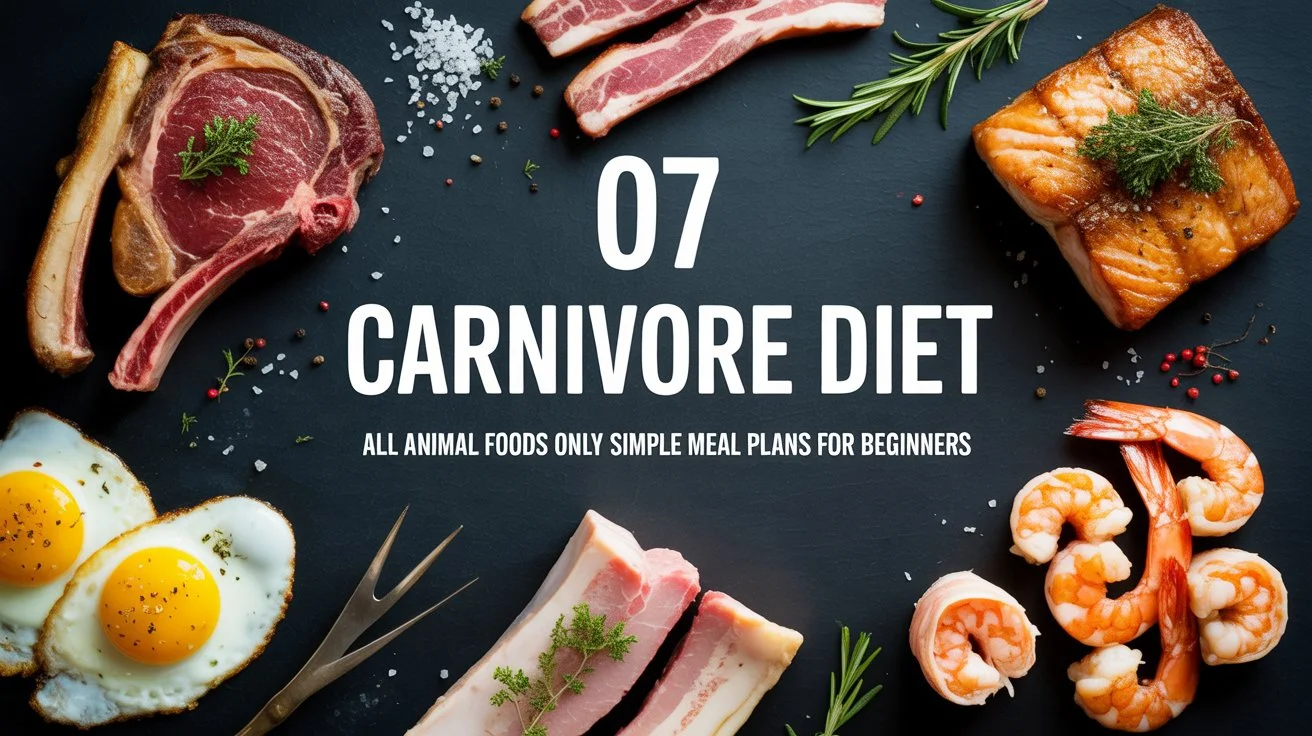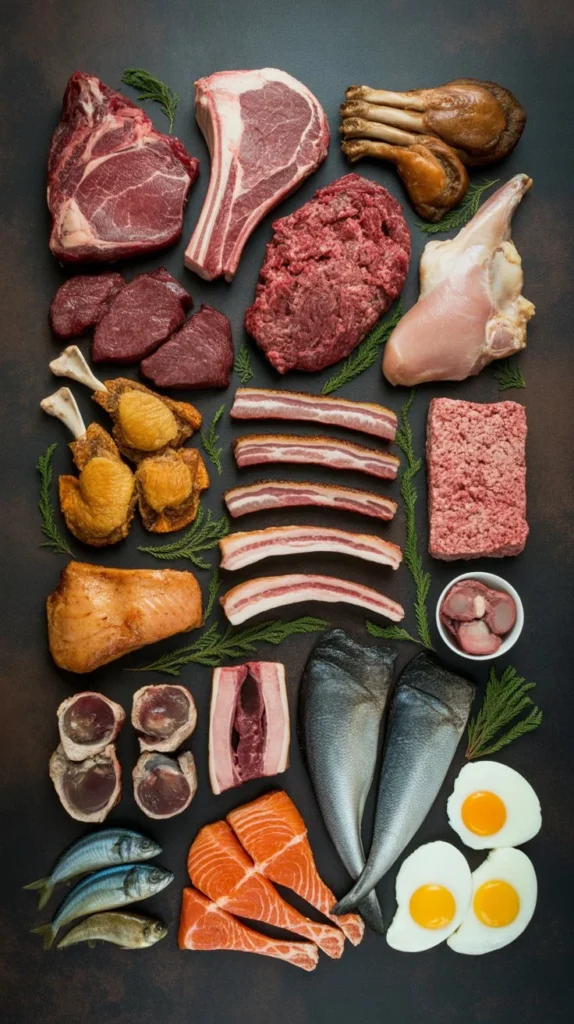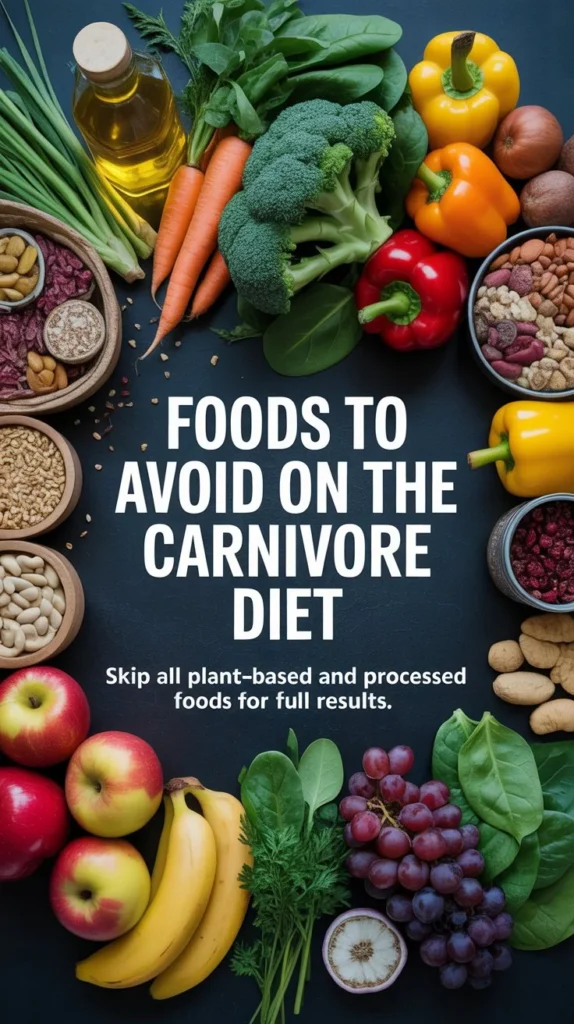Best carnivore diet

What Is the Carnivore Diet?
The carnivore diet is an eating plan that includes only animal products. People who follow this diet eat meat, fish, eggs, and sometimes dairy while removing all plant-based foods like vegetables, fruits, grains, nuts, and seeds.
This way of eating eliminates all carbohydrates and focuses entirely on protein and fat, with meals consisting of beef, pork, chicken, fish, and eggs. Followers believe this approach can help with weight loss, boost energy levels, and reduce inflammation in the body. The diet works on the principle that humans can thrive by eating animal foods alone, similar to how our ancestors ate thousands of years ago.
Foods You Can Eat on This Diet

The carnivore diet gives you a clear list of animal-based foods to choose from each day. Your meals come entirely from meat, fish, eggs, and select dairy products. Understanding what you can eat makes planning your meals simple.
- Beef and Red Meat Ribeye steaks, ground beef, chuck roasts, brisket, and short ribs all fit into your daily eating. Fattier cuts provide more energy and keep you satisfied longer.
- Pork Bacon, pork chops, ground pork, spare ribs, and pork belly give you tasty options. The fat adds flavor and helps meet your daily energy needs.
- Poultry: Chicken thighs, drumsticks, wings, and turkey legs work perfectly. Keeping the skin on adds the fat your body uses for fuel.
- Lamb and Goat Lamb chops, leg of lamb, and ground lamb offer rich flavors with healthy fats and proteins.
- Organ Meats, Liver, heart, kidney, and bone marrow pack the most nutrients. Many people mix ground liver into regular ground beef to boost nutrition.
- Fish and Seafood Salmon, mackerel, sardines, tuna, shrimp, and oysters bring variety. Fatty fish provide omega-3 fats that support brain and heart health.
- Eggs: Chicken eggs, duck eggs, and quail eggs give you protein and healthy fats. You can prepare them any way at any meal.
Foods to Avoid Completely

The carnivore diet requires you to remove all plant-based foods and processed items from your meals. This means skipping everything that grows in the ground or comes from plants. Knowing what to avoid helps you stay on track and get the full benefits of this eating plan.
- Vegetables: Broccoli, spinach, lettuce, carrots, peppers, tomatoes, and all other vegetables need to go. This includes starchy options like potatoes, sweet potatoes, and corn.
- Fruits Apples, bananas, berries, oranges, grapes, and all other fruits, contain natural sugars. These carbs can stop your body from burning fat for energy.
- Grains and Bread Wheat, rice, oats, quinoa, bread, pasta, and cereal all come from plants. These foods add carbohydrates that the diet eliminates.
- Legumes and Beans Black beans, lentils, chickpeas, peanuts, and soybeans contain both carbs and plant proteins that do not fit the diet.
- Nuts and Seeds: Almonds, walnuts, cashews, sunflower seeds, chia seeds, and flaxseeds all come from plants. Even though they contain fats, they still break the diet rules.
- Oils from Plants Olive oil, vegetable oil, canola oil, coconut oil, and seed oils, need replacement with animal fats. Use butter, tallow, or lard instead.
How This Diet Affects Your Body
The carnivore diet creates major changes in how your body processes food and produces energy. Removing all carbohydrates forces your system to use fat and protein as fuel instead of glucose. Your body starts breaking down fat for energy within three to five days, creating ketones that fuel your brain and muscles. Blood sugar stays steady all day without spikes and crashes. Digestion becomes simpler, and most people experience fewer stomach issues after two weeks.
Protein and fat keep you full much longer, so hunger hormones stabilize and cravings disappear. Most people naturally eat just two meals per day. Your body burns stored fat while protecting muscle tissue because of the high protein intake.
You lose stored water during the first week and need extra salt to replace lost minerals. This prevents temporary tiredness and headaches during adjustment.
Health Benefits People Experience
The carnivore diet brings noticeable changes that many people report within weeks of starting. These benefits come from removing plant foods and focusing only on animal-based nutrition.
- Weight loss happens quickly as your body burns stored fat for energy. Many people lose 10 to 20 pounds in the first few weeks without counting calories because high protein reduces hunger naturally.
- Energy levels increase, and mental clarity improves once your body adapts to using fat for fuel. People report better focus and no afternoon crashes throughout the day.
- Digestive problems like bloating, gas, and stomach pain often disappear within two to three weeks. People with IBS and acid reflux notice major improvements.
- Joint pain and inflammation decrease significantly. People with arthritis report less stiffness and swelling after removing foods that trigger inflammatory responses.
- Skin conditions like acne and eczema clear up for some people after the first month. Blood pressure and cholesterol markers also improve after three to six months.
- Mental health benefits include reduced anxiety, better mood stability, and improved sleep quality at night.
Possible Side Effects and Risks:
The carnivore diet can cause several side effects as your body adjusts to eating only animal foods. Some risks may appear during the first few weeks, while others could develop over longer periods.
| Side Effect/Risk | When It Happens | What You Experience |
| Adaptation Flu | First 3-7 days | Headaches, fatigue, dizziness, brain fog, and muscle cramps as your body switches to fat burning |
| Digestive Changes | First 1-2 weeks | Diarrhea or constipation, changes in bowel movements, and stomach discomfort |
| Electrolyte Imbalance | First week onwards | Low sodium, potassium, and magnesium cause weakness, heart palpitations, and muscle cramps |
| Nutrient Deficiencies | After 3-6 months | Low vitamin C, fiber absence, and potential lack of certain minerals if organ meats are avoided |
| High Cholesterol | After 2-3 months | LDL cholesterol may increase for some people, though HDL often improves too |
| Kidney Stress | Long-term concern | High protein intake may strain the kidneys, especially for people with existing kidney problems |
| Constipation | First 2-4 weeks | Lack of fiber slows bowel movements until your digestive system adapts |
| Social Challenges | Ongoing | Difficulty eating out, attending social events, and explaining your diet to others |
| Increased Thirst | Throughout | Your body needs more water due to reduced water content in food and electrolyte shifts |
Sample Meal Plan for Beginners
This seven-day meal plan helps you start the carnivore diet with simple, easy-to-prepare meals. Each day includes two to three meals focused on different types of animal foods.
| Day | Meal 1 | Meal 2 | Meal 3 |
| Day 1 | 4 eggs scrambled in butter with 4 strips of bacon | 8 oz ribeye steak with salt | 8 oz ribeye steak with salt |
| Day 2 | 6 oz salmon cooked in butter | 10 oz chicken thighs with skin | 3 hard-boiled eggs |
| Day 3 | 4 eggs fried in bacon grease with 3 sausage links | 8 oz pork chops with butter | 6 oz deli roast beef slices |
| Day 4 | 6 oz ground beef with 2 fried eggs on top | 8 oz New York strip steak | 4 oz cheddar cheese with salami |
| Day 5 | Omelet with 4 eggs, cheese, and ground beef | 10 oz lamb chops cooked in tallow | 6 oz canned tuna with butter |
| Day 6 | 6 strips of bacon with 3 scrambled eggs | 12 oz burger patties with cheese | 6 oz grilled shrimp |
| Day 7 | 8 oz pork belly with 2 fried eggs | 10 oz beef brisket | 4 oz liver pate with butter |
Daily Reminders:
- Drink water throughout the day
- Add salt to every meal
- Cook with butter, tallow, or bacon grease
- Eat until satisfied, not stuffed
- Skip Meal 3 if you feel full after two meals
Tips for Long-Term Success
Staying consistent with the carnivore diet requires planning and smart strategies. These practical tips help you maintain this eating style for months or years.
- Buy meat in bulk during sales and store it in your freezer to save money.
- Prep meals on weekends by cooking several pounds of meat at once for the week.
- Keep meals simple with basic options like steak and eggs instead of complicated recipes.
- Mix small amounts of ground liver into regular ground beef to boost nutrition.
- Track your energy, sleep, and mood instead of just watching the scale.
- Join online carnivore groups for support, meal ideas, and motivation.
- Bring your own food to social events and ask restaurants to cook plain meat.
- Drink plenty of water and add salt to every meal to replace lost minerals.
- Stock easy backup options like canned fish, deli meat, and hard-boiled eggs.
Final Thoughts on Making It Work
The carnivore diet works best when you approach it as a personal experiment and pay attention to how your body responds. Give yourself at least three months to see real changes in weight, energy, and health markers before judging if this eating style fits your life. Listen to your hunger signals, keep meals simple, and accept that social situations will require extra planning.
Remember that this diet serves as a tool for better health, not a rigid identity, so you can adjust based on your results and goals. The key is finding what makes you feel healthy, satisfied, and sustainable for your life.RetryClaude can make mistakes. Please double-check responses.
